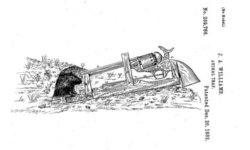Last month, we discussed issues in obtaining a design patent. This month, we look at issues in enforcing the design patent.
Remember that utility patents and design patents are separate and distinct and protect different things. A design patent addresses the appearance of something; for example, the appearance of a mousetrap that looks like a piece of cheese. A utility patent addresses what an invention is and how it works; for example, a mousetrap that plugs the mouse with a .44.
Last month, we explained that design patents are pretty easy to obtain because of the restrictions on novelty and obviousness rejections (though that is likely to change). As we saw last month, for a design invention to be obvious, there must be a prior art reference that is VERY like the appearance of the design invention.
But how close to the patented design must a competitor’s design be to infringe the design patent?
The starting point is the ‘ordinary observer‘ test from 1871:
“Two designs are substantially the same if, in the eye of an ordinary observer, giving such attention as a purchaser usually gives, the resemblance between the two designs is such as to deceive an ordinary observer, inducing him to purchase one supposing it to be the other.”
Well, that’s clear enough. If a purchaser would be fooled by a copyist into buying the wrong product, then the design patent is infringed. This broad rule works great where the design patent addresses a completely original, new design, and there are no close prior designs. (Think of the key-free face of the original iPhone.) Like every other simple rule (thou shalt not kill?), the simple ‘ordinary observer’ test breaks down at the margins with exceptions and explanations.
Now a stroll through the weeds.
As we saw last month, a design patent can issue even if very close to prior designs. So let’s take a look at the margins; namely, those design patents where there are lots of close prior designs, referred to as ‘comparison prior art.’ The court (or a jury) will compare the copyist’s design to the patented design and to the ‘comparison prior art.’
a. If the comparison prior art is close to the patented design, then even minor changes between the patented design and the copyist’s design suggest that the copyist’s design DOES NOT infringe the design patent. Why? Because the patented design is itself only a minor change from the ‘comparison prior art,’ should have a very narrow scope, and hence is not a very valuable design.
b. If the patented design has features that are different from the ‘comparison prior art,’ and the copyist copies those new features, then that suggests that the copyist’s design DOES infringe the design patent. Why? Because the copyist has copied the very features that set the patented design apart.
The closer the patented design is to the ‘comparison prior art,’ the more important the two above factors will be.
So, which prior designs are ‘comparison prior art?’ According to the recent Federal Circuit case of Columbia Sportswear v Serius Innovative Accessories, only prior art directed to the same product as described in the claim of the design patent qualifies as ‘comparison prior art.’ For example, an ornamental design applied to a sofa is not ‘comparison prior art’ for an identical design applied to a toilet bowl. In the Columbia case, the patented design was of a ‘heat reflective material.’ This new limitation will substantially restrict the application of ‘comparison prior art’ to design patent infringement.
All very fuzzy, we know, and subject to interpretation and argument. In the (paraphrased) words of our late partner Treb Lipton, “the world is run by English majors.” This author adds “judges are very comfortable with ambiguity.”
There’s one special case that deserves a special mention. How about if a competitor copies every part of the patented design, but prominently includes the competitor’s own logo in the design (as in the Columbia Sportswear case)? There can be no possibility of confusion and hence no infringement, right?
Wrong. The courts have long held that a logo alone does not distinguish a competitor’s product from a patented design to avoid infringement. The reason is that a design is different from a trademark. A trademark indicates the source of a good or service and infringement of the trademark also turns on confusion. But the confusion that’s important to design patenting is not to the source of the product, but to the design itself.
Now here’s the fuzzy part. If the inclusion of the logo changes the design (see factor (a) above), then the copyist’s design, as modified by the logo, may not infringe the design patent. Arggh.
See the Columbia Sportswear decision for more on this topic.
— Robert Yarbrough, Esq.



